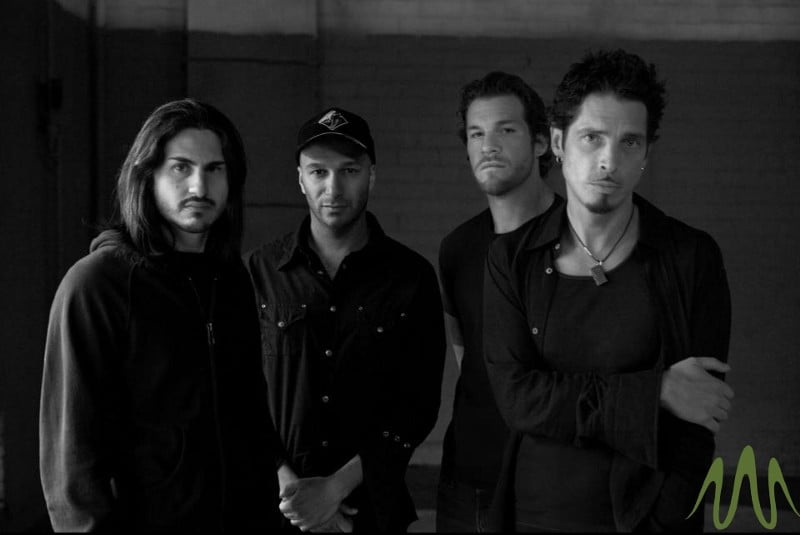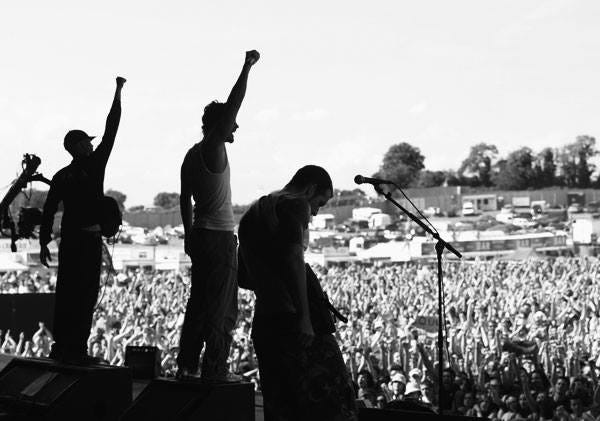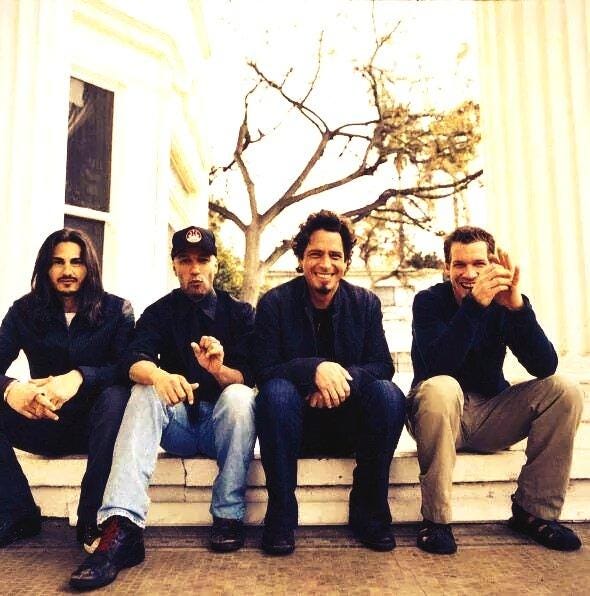
Featuring Audioslave/RATM/Prophets of Rage Bassist — Tim Commerford
If you look closely at the liner notes of each Audioslave album you will notice the sentence — all sounds made by guitar, bass, drums and vocals.
So what exactly was Audioslave? My response — a powerhouse. Audioslave. What a perfect name for a group of four storied musicians that created an original fire using only the eight hands between them. Believe it or not, it’s now been 15 years since Audioslave first came together. Though their run was a short six years, it was an explosive and dynamic six years, holding very true to their name. As Rage Against the Machine split up with Zack de la Rocha leaving, guitarist Tom Morello, bassist Tim Commerford and drummer Brad Wilk, found themselves eager to continue on with the core they had built. Nothing could serve as a Rage version two however, so the clear path was to form a new band. As you can imagine the trio was inundated with requests, suggestions and trials from those a bit too similar to de la Rocha’s style.
About 1,100 miles up the west coast, Chris Cornell found himself in the aftermath of quite a successful and incredibly moving solo record, Euphoria Morning, as Soundgarden had disbanded in 1997. Much to the surprise of both parties, it was acclaimed producer Rick Rubin who suggested that Morello, Commerford and Wilk get together with Cornell. The timing seemed to be perfect. When asked about his initial thoughts to Rubin’s suggestion, Commerford has as much enthusiasm in his voice now as he did then, “I immediately thought about Badmotorfinger. It’s one of my favorite records. I spent so much time with that record, just loving it. I thought about ‘Slaves & Buldozers’ and ‘Jesus Christ Pose.’ These are songs that are anthems to me. It was so exciting.”
Commerford explains, they immediately started thinking about the endless possibilities of having Cornell’s voice blend with their music. “I think the first day Rick hit us up with Cornell, we were at his house and we all listened to ‘Slaves & Bulldozers’ and we discussed how Cornell could just do anything. Little did I know it was not really going to go in that direction. I see Audioslave as more classic rock, singer, chord progression type of music. Things like that, we never really did with Rage.” If you think about it, in theory, it just seemed to be a natural pairing. Three robust musicians joining forces with an unmistakably potent voice that’s an instrument unto itself. All sounds made by guitar, bass, drums and vocals. Again — how fitting. Those four could pull that off.
Arrangements were made for the group to get together in Los Angeles. Though the sparks flew right away, the music served as a new challenge for each member. “I think back on it and I love Rage, I love the way it feels, and then Audioslave happens and it was so different. That’s the thing that I am most proud of. We didn’t just come back and make a bunch of riff rock and put Cornell’s vocal on it. We did something genuinely different.”
From that first session came the band’s first song, “Light My Way,” which would ultimately serve as track 12 on their debut record. Commerford vividly recalls that first jam saying, “I remember being a little nervous initially. We had been playing with Zack for so many years and then here’s another guy. It was a little nerve-racking to be playing with another singer who I didn’t know. I had met Chris a couple of times, but I didn’t really know him at all. At that time, he wasn’t exactly at his best. It was a bit uncomfortable at first, but we wrote ‘Light My Way’ during that first day and it ends up being on our first record. We left there that day thinking — We did it. This is cool. We wrote a song and it sounds good. That was it. That little fire ignited the whole thing. I think that’s how the best music works. You’re uncomfortable until you write a song that you like and that inspires you to write more.”
After that first session, the group knew they could be a band and they could be something special. It was a wave they wanted to continue to ride while the momentum was fresh. As easy as it all began, there was a period shortly after where things got somewhat complicated. A courageous Commerford was determined to make Audioslave happen. “We got together and wrote songs quickly. Then we had some turmoil regarding management. We had a different management company than Chris and that caused a few problems. The next thing you know, it felt like things were falling apart before it even began. We had written a record, but for a second it didn’t feel good. Chris kind of went MIA. Chris is such a different person now. He’s on top of his game and on an all-time high, but at that time he was Seattle Chris Cornell. He went Seattle on us. I personally went to Seattle. I searched for him and I found him. By finding him, I found myself in jail. Not because he was there, but because I ended up in there. That trip to jail cost me a ton of money. I look back on that and think that was money well spent because that was a big part of why Audioslave actually became a band. It was worth every penny. I found Chris and I dragged him out of Seattle and we became a band that made a lot of records in a short period of time.”
Cornell often credited his bandmates for helping him at that time. Cornell’s wife, Vicky, is very grateful to Commerford for his thoughtful efforts telling me, “Chris was dying in Seattle. Timmy C stepped up like a real friend and saved him. He will always be one of the most special people to Chris. If only others had half the balls or the heart of Timmy C.”
From there, the rest of the Audioslave story is history. Three distinguished records were released over the course of four years. Writing songs was somewhat of a seamless process explains Commerford, “All four of us would get in a room and just start crafting something, whether it came from a vocal part of a chord progression. Sometimes it was something Chris would have or a riff one of us played or a drum beat. There would be some sort of inspiration where we would all think it was cool and worth continuing. Chris would be thinking of lyrics and melodies and would often hum a melody over a riff. We’d built the song with all four of us there. Once it was built and we knew what the structure was, Chris would go back and figure out the lyrics.”
The band toured extensively, making their world debut atop the marquee of the Ed Sullivan Theater in New York City, for The Late Show with David Letterman. It was the first time a band would perform on the marquee. (We’ll get to another “first” shortly.)
“I’ve been watching. Why you been coughing. I’ve been drinking life while you’ve been nauseous.” Well, hello world. Let us introduce ourselves via the song “Cochise.” Damn.
Like the name Audioslave that so eloquently encapsulates the band’s music, the video for “Cochise” is one of the best introductions to a band of all time. It’s simple, completely honest and grabs every inch of emotion to what was taking place. Cornell stands alone atop a dark industrial building. Pacing. Eager. Down below, an army-looking pickup truck storms in with Morello, Commerfod and Wilk sitting on the edge. They jump out, hit the elevator and Commerford takes an anxiety-laced deep breath (one of the best parts) as the elevator delivers them to an awaiting Cornell. Shot out of cannon, they arm themselves with instruments, take their positions and BOOM!

Audioslave’s collection of music offered straight-ahead, smack you in the mouth rock, but with a sensitive side. It’s some of Cornell’s most direct and inspiring lyrics. The songs showed more of personal, story-telling Cornell, touching upon life experiences everyone could relate to. Cornell took you on his personal journey with him. Songs like “Doesn’t Remind Me,” from their middle record, Out of Exile, give you that — lace up your boots, grab your coat and let’s go take a walk and have a cleansing chat type of feel. “Audioslave is basic Rock n’ Roll. There were times that it felt pretty mainstream. But its music that I know, when I’m 80 years old, I’m going to turn on an Audioslave record and feel good about it,” says Commerford.
On May 6, 2005, Audioslave became the first American rock group to perform an open-air concert in Cuba, as they played a free show in Havana before an estimated 70,000 people at the La Tribuna Antiimperialista. This was during the embargo and required a special permission from President Bush and Fidel Castro. The band was only allowed to announce the concert one day before, given it would be considered an exemption. The purpose of the show followed suit with what Audioslave always exemplified — celebrating the power of music.
15 years later, Audioslave’s music is as prominent now as it was during its peak. Songs like “Like a Stone” (their biggest hit), “I am the Highway,” “Show Me How To Live” and “Be Yourself,” are in continual rotation amongst most rock platforms. Cornell features many Audioslave classics and rarities within his solo acoustic sets. Most importantly for the band themselves, they built something they truly appreciate. “To me, the legacy is being proud of what we did and what we didn’t do. We didn’t do what we do. We did something different for all of us. I’m so proud to listen to it and think — Wow, look at that. There’s a legit chord progression. I was playing bass and working off a vocal melody. Who would’ve thought I even had that in me? I certainly didn’t know that. I’ve never been in that situation. I had only been in a band where I play riffs and had a guy rapping on it. When somebody is singing, you have to be conscious of what they’re doing. As we made records, we became more in tune with thinking about that.”
Looking back, you get the sense Commerford really marvels at what Audioslave did in their time. He feels their third and final record only scratched the surface of what the band could have done next. “I look at that last Audioslave record and think it’s too bad we broke up when we did. Revelations to me was such an achievement. That was a great album. I hear some of those songs, and I don’t even remember the names of some of them, we never toured on it, we broke up right after we made it, and that is such a great record. It sounds great. Brendan O’Brian produced it. It’s amplified and it’s all there. You hear all the minor differences sonically and I love that.”
Commerford truly recognizes the uniqueness to what the band subconsciously did. Their approach naturally lead them to uncharted waters. “We never once said, let’s make a record that’s like Badmotorfinger or that’s like a Rage record with Chris singing on it,” he said. What makes Commerford most proud now is the bond between the four members of Audioslave. You get the sense they all share Commerford’s feeling of — Wow, we did that! “We all really get a long in an adult way. As you get older, you let go of things, you turn the page,” he said. Commerford also credits Cornell as being a driving force behind his motivation to launch his new hard-driving, punk-influenced band, Wakrat. “I really respect Chris more than ever right now. I went and saw him play at Disney Hall and it was so great. He came to my Wakrat show and was so supportive. After the show he talked to me for hours about it. He broke it down and told me how he loved what I was doing, it was so hard, but with a vulnerable side that I should embellish on. I took what he said to heart. It was a huge inspiration to what I am doing now. I love that guy. I think he’s an amazing musician. His voice is incredible. He understands his voice better than he ever has, not to mention how good of a guitar player he is. He’s just an incredible dude,” said Commerford.
As to what the future could hold for Audioslave, Commerford says, “I know there are some songs we recorded that were never put out, but were good. I’m sure eventually someday they’ll go out there.”
“Can’t explain it, it was something to see. Can’t contain something so ever real.” — Audioslave “Original Fire,” lyrics. Fascinating how a song initially written about the early 90’s Seattle movement can now be applied to the band that wrote it.
~If you enjoyed please recommend and follow Artist Waves — on facebook, twitter & medium
By: Jeff Gorra
jeffgorra@gmail.com
Article also featured on Alternative Nation




